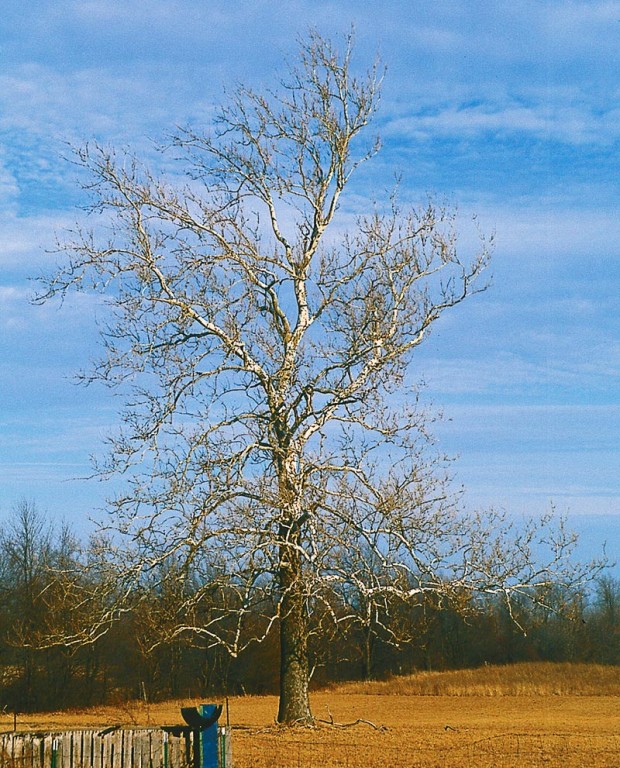
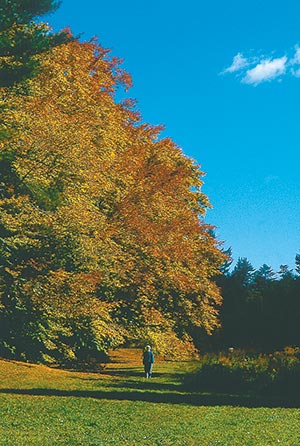
“Have you seen those little holes they left in the new sidewalks downtown? For trees?! How do they expect a shade tree to grow in such a tiny space?”
It’s my turn to speak. My mind races through a lifetime of feelings about trees. What I see on that journey both surprises me and changes my position in a subtle and important way. Here’s a replay of that mental ride which begins back in my youth.
It’s great weather and I long to be outside, playing with my friends. We’re all under orders, however, to stay inside with all windows closed today. Standing at an upstairs window, I am still well under the canopy of a big elm at streetside. With the elms on each side and across the street it forms a solid ceiling.
I live in awe of the elms. Planted in the 19-teens, they are shading their third generation of hopscotch games and Sunday walks to church. Some are so big that the trunk fills the entire space from sidewalk to curb.
A truck unlike any I have seen proceeds along the street, a cannon on its back spraying fog into that high elm ceiling. I do not understand what is happening, but it has to do with the trees, so it interests me.
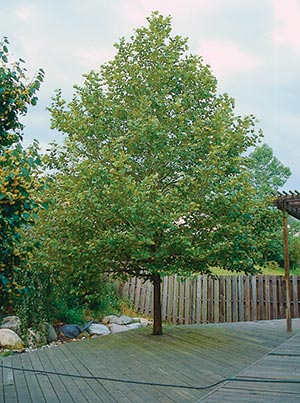
Next, I’m sitting on the front steps, in my pajamas. It’s nice that the elm in front of the house is gone because at dusk we can sit here and watch bats swoop and dart across the opening.
Then, I’m walking with friends, passing through alternating sections of light and shadow. We stop and kick at rings of mushrooms growing where those huge tree trunks once were. At a new ash, we take turns holding onto the trunk and pivoting around the tree. It’s such an odd thing, to be able to put one’s hands completely around a tree trunk.
Later, I’m a driver, taking in the neighborhood as a whole. What a shame that the big trees are gone. Some of the new ones snapped or stayed small, but some have begun to grow. Following belatedly in the path taken by adults of the neighborhood, I resign myself to waiting for the leafy ceiling to regrow.
As a young married, I shop for a house. To my husband and me, big trees are synonymous with a perfect home, but we buy a treeless house anyway. The seller tells us that the trees it had in front died a while back. There are trees on the neighbors’ lawns – not huge, but they do cast some shade. We plan to plant some of our own right away.
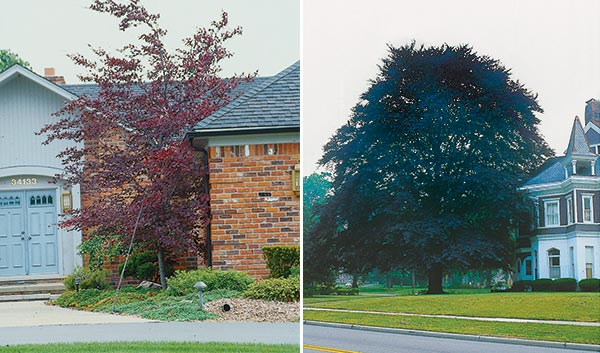
A few years later we put cranky, over-tired children to sleep with slow car rides through the new, smoothly paved subdivisions that are all around. Expert now in landscaping—we’ve planted and killed three trees in our yard, but feel we now know enough to keep the fourth, fifth and sixth alive—we cluck our tongues over the dinky trees lining these roads. We’re that much more grateful for the big elm and maple next door, and the neighbors’ tolerance of small children. Those trees are child magnets—meeting places for the young of the neighborhood. We wonder if our own trees will someday support tree houses and a crowd of climbing kids, like the trees of our childhood.
At high school graduation parties for our children’s friends, we look at trees in these other neighborhoods. So many streets with rows of ash or linden, trees that are still only ornament. Yet where there are larger trees casting pools of car-parking shade, the setting is quite unlike what we knew as children. These trees have a weakness to them – battle-scarred trunks and patchy crowns. Are we noticing this because we have made trees and plants our profession, or are they truly stunted and embattled as the elms of the 1950s and 60s never were?
Driving to a baby shower for a friend’s first grandchild, we pass the latest construction projects. Road work, installation of a big new drain, traffic accidents, and development of properties alongside have taken their toll. What was a green belt of big trees is a fading memory.
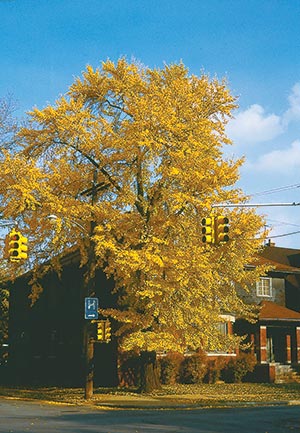
Back to the present and the discussion of a city’s new street tree planters. I’m brought up short. I have suddenly realized that our resigned waiting has lasted more than 40 years but still the big trees are not back! In four decades the replacement maples and ashes should have reached 60 feet tall or more but only a small percentage have done that. In many cases the elm replacements have themselves been replaced two or more times, having succumbed to disease, accident or side effects of paving, utility digs and reconstruction coming at increasingly short intervals.
We lost our trees to elm disease, replanted and waited for the time when things would settle down and return to “normal.” While we’ve waited, the world has changed in many different ways, some of which we fail to see. One of those blind spots has swallowed our big trees.
From the perspective of an era of elm-lined streets, it’s criminal to put a tree into a small hole surrounded by concrete. To those who see the reality of modern living, it’s business as usual.
Given the proliferation of underground utilities and related work, plus the frequency of major road changes and commercial area make-overs, trees along main streets and even most side streets won’t grow undisturbed for more than a decade. They cannot ever attain their old stature, aren’t expected to, and would even be an inconvenience to routine if they did. Air conditioning units in every building and car have devalued tree shade. Trees are planted now out of habit, and/or are designed into new, instant landscapes because nothing else provides enough height and mass to offset the new buildings they front.
We pave too much, dig too often, drive too recklessly, wield too many mowing and trimming tools at too great a pace to have big trees along our streets anymore. This is not evil nor is it a temporary condition. Changing our ways to once again accommodate big trees along the roads would mean that too much of the life we pave, dig, drive and rush to enjoy would also have to change, which is simply not realistic.
It’s time for my generation to shake itself and see this. We have to begin lobbying not for larger planting holes where modern life makes such a thing impossible, but more frequent replacement of trees that have reached their limit in those holes. More important, we have to plant more wisely, and soon (in places not along streets!), or the grandeur, reassurance and pleasures that come from mature trees will not be a part of our children’s children’s lives. Many of our children have already missed that experience.
I hope each gardener will look around and find a place where a tree can be expected to grow to maturity. Whether that’s in a back yard, neighborhood park, or subdivision commons area, let’s each plant one appropriate new tree or adopt an existing tree with potential and protect that tree. We can research the species to determine how big it can grow and how quickly. We can project that mature canopy and root mass onto the existing landscape and find ways to give the tree room to grow to those limits, both above and below ground.
I’ll water my tree during droughts, and learn what insects and diseases to watch for and fend off if they come. I’ll be its advocate when human activities around it become threatening and pass its care on to my children, heirs or successors on the land. I won’t ask that they keep everything in the landscape as I had it, just that they continue the stewardship of one particular tree.
In this way we may preserve and continue to grow big trees. Better yet, we’ll maintain the connection between growing people and growing things, one of the most precious relationships of all times.
Janet Macunovich is a professional gardener and author of the books “Designing Your Gardens and Landscape” and “Caring for Perennials.” Read more from Janet on her website www.gardenatoz.com.

norm says
I totally agree. Can you suggest a few trees that are your favorites for planting in urban settings?, particularly street plantings and urban developments.
jhofley says
Hi Norm-
Here is a link to a tree tips article with some ideas. There is also another article by Janet from our archives that we’ll post and notify you when we do. Thanks for reading!
-Eric & Jonathon
Ron McLachlan says
I found the article on poor site selection for trees interesting since I can relate from personal experience. I live in Livonia MI in an area of alkaline clay soil. In the mid eighties I planted a pin oak tree. Two of my neighbors did also a few years prior to me. In recent years they had to remove their trees and I am faced with the prospect of doing the same after years of treating the soil with sulfur, miri -acid etc trying to make the soil acidic. The tree started out beautiful with shiny dark leaves when it was young. They are mostly yellow now. I planted the tree because I read in the newspaper that is was an ideal tree for this area. Very sad to lose a tree not from disease but from poor site selection or soil incompatibility.
Thank you for including me on your e-mail list. It was a gardening friend who first made me aware of your news-letter.
Dorothy Hastings says
I, too, remember the stately elm trees as well as the truck that came down our street spraying for Dutch elm disease. Ironically, I now am stuck with a Siberian elm in my backyard, a very poor cousin to the elms of my youth. Down the street I’ve taken on the task of neighborhood park steward. Grassy space is being swallowed by invasive buckthorn, boxelder, and honeysuckle; the latter is hindered by massive grape vines as thick at their base as my wrist. While Janet urges us to plant trees, I am whacking away at the invasive ones. Please help your neighbors identify invasive species then encourage their removal.
Alice says
About those grapevines, Dorothy. Don’t go crazy chopping them out. We did that last year, then discovered that wild grape is a favorite food for cardinals. We had cardinals everywhere last year. This winter,we have seen almost none.
Dick Moldenhauer says
Wow. You’re right. I never looked at it that way. As a youth there was a big maple in the front yard lost to street widening, a big elm in the side yard that went to build a house and a bigger cottonwood that was “in the way”. I planted 2 ash where I live now and both succumbed to EAB. I still have a locust that has a 28″ trunk though.
Alice says
I love the big, old trees. My parents had a five-trunk elm, the largest of which was at least three feet in diameter. It was on the south side of the house, so we needed no air conditioning, and it was on a small berm,, so we’d swing Tarzan-style over the lower lawn, and the Baltimore orioles were plentiful. When that tree died, we mourned, and then all the other elms died, and it seems that almost everything else is gone now.
It hurts when I see how the tree services for the utility companies butcher the trees. My husband oversees the operation when they attack our ours, so they still look like trees. Our city still has some stately trees, including gingkos and elms, but we also have an aggressive lumber person who is constantly trying to buy peoples’ trees.
The tree man who came to our home to take out large dead trees said that there is only one tree that seems to have no enemies, and that is a Bradford pear, but it has its own problems.
However, you stated the leafy canopy as a visual obstacle. I know what you mean, because my area has mostly Chinese elm, catalpa, and box elder, with a few maple and oaks scattered about. It’s amazing how the contours of the earth show during the winter, and in the summer,it seems more like a cocoon. The point is that this is everywhere, and we need to think of each day with trees as a gift that too many planners cannot see.
Sue Roberts says
Dear Janet,
You did a sound history lesson on the changes that occured with the loss of many kinds of large shade trees. I remember as a kid losing 5 elms on our property and was distressed that there was next to nothing we could do. I advocate tree planting of any kind except cottonwood which gets allergies engaged.
In the 22 yrs we lived in our Oakland Co. home, my husband and I have planted a variety of 18 ornamental and shade trees. It started out, that I just wanted a small area in the front yard to become a more enhanced garden when my grandma died. I had made a grouping of trees and perennials to honor grandma and her love for trees and gardens. It had small pines including a blue spruce. Since experience can be a good teacher, I learned about how crowded clumps of adult trees look 15 years later. I found I had neglected to pay attention to trees and bushes’ dinensions. Scaling things properly also matters. Because we also lost a choke cherry tree to relentless ants, the spruce has had the elbow room to grow up and out to its full glory. Many bird varieties have a good time making nests and raising their young in our plantings. The deer are attracted to the apple trees next door too. Our grandkids help me now with my plantings. Life is good.
Sue
In Commerce
Lynne says
We have a large locust in front of the house (Lincoln Park), a replacement years ago for a deceased elm. It’s done well, and I had it trimmed a bit a few years back to keep it from the streetlight and the gable in front of the house. Last year was my first full summer of retirement, and I had the time to watch the cicadas hatch.
Joan says
I grew up in the Grandmont section of NW Detroit. Our street was completely shaded by the elms that arched on either side. Then along came Dutch elm disease and there went the trees. We built a house in White Lake and have woods on 2 sides of our property. Many of the huge trees are thorney locusts and cottonwoods. Several are oaks. Frankly, they are all “dirty” trees. Some of the oaks still haven”‘t dropped their leaves! We’ve planted 4 maples, a crabapple and 2 high bearing peach trees as well as several conifers. Love them! They look lovelier each year (It’s been over 10 years for some now) and are growing happily. Thankfully they provide shade or fruit without dropping stamens, acorns and seed pods. After a beautuful color display or a bountiful fruit harvest they drop their leaves timely. I do love trees, but I am selective and not a fan of “dirty” trees. (I’ve picking up the thorny locust seed pod since the snow disappeared and still will probably be pulling 1,000 seedling from the gardens!